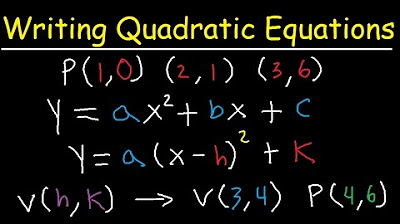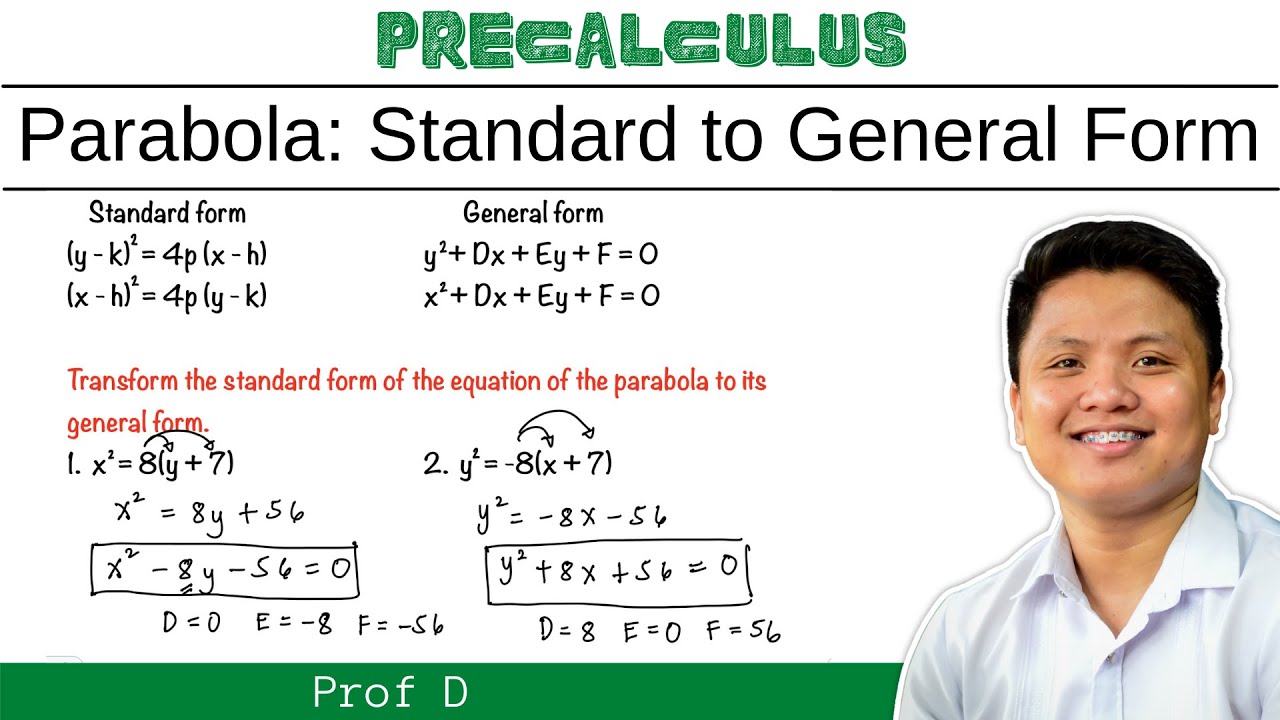STANDARD EQUATION OF PARABOLA TO GENERAL FORM
TLDRIn this educational video, Eleanor Valencia from Group Two guides viewers through the process of writing the standard equation of a parabola in its general form. Using four examples, she demonstrates how to manipulate the standard form equation to achieve the general form by completing the square. The examples cover various scenarios, including equations with different coefficients and vertex positions. Valencia's step-by-step approach ensures that viewers can follow along and apply the method to other parabolas. The video concludes with simplified general form equations for each example, showcasing the versatility of the technique in solving quadratic equations.
Takeaways
- 📚 The presentation is about writing the standard equation of a parabola in a general form.
- 👩🏫 Eleanor Valencia from Group Two is the presenter of the tutorial.
- 🔢 The first example involves transforming the equation \( x^2 = 2(x + 4) \) into its general form.
- 📐 The vertex form for a parabola is \( (x - h)^2 = 4a(y - k) \) and is used to derive the general form.
- ✂️ The process involves isolating the squared term and moving other terms to the opposite side of the equation.
- 📈 The second example transforms \( y^2 = \frac{1}{3}(x - 4) \) into a general equation.
- 📉 The third example starts with \( (y - 2)^2 = 4(x + 1) \) and simplifies to a general form.
- 🔄 The fourth example involves the equation \( (x + 4)^2 = x - 2 \) and is simplified to a general form.
- 📝 Each example demonstrates the step-by-step process of converting vertex form to general form.
- 🎶 Background music is played during the presentation, indicating a multimedia approach to the tutorial.
Q & A
What is the main topic of the video presented by Eleanor Valencia?
-The main topic is teaching how to write the standard equation of a parabola in its general form.
What is the general form of a parabola's equation when written as (x-h)^2 = 4a(y-k)?
-The general form of a parabola's equation in this case is x^2 - 2ax - 2by + 2ah - 2bk + h^2 + k^2 - a^2 = 0.
In the first example, what is the original equation given?
-The original equation is x^2 = 2(x + 4).
How is the general form of the equation obtained from the first example?
-By multiplying 2 to (x + 4) and then moving the resulting expression to the other side of the equation.
What is the vertex of the parabola in the first example?
-The vertex is at (0, -4).
In the second example, what is the original equation and how is it transformed?
-The original equation is y^2 = (1/3)(x - 4). It is transformed by multiplying (1/3) to (x - 4) and then moving it to the other side of the equation.
What is the vertex of the parabola in the second example?
-The vertex is at (4, 0).
How does the third example's equation differ from the first two?
-The third example's equation is (y - 2)^2 = 4(x + 1), which involves squaring y - 2 and multiplying by 4, then moving the expression to the other side.
What is the vertex of the parabola in the third example?
-The vertex is at (-1, 2).
In the fourth example, what is the original equation and how is it manipulated to get the general form?
-The original equation is (x + 4)^2 = x - 2. It is manipulated by squaring x + 4, multiplying by 4, and then moving x - 2 to the other side of the equation.
What is the vertex of the parabola in the fourth example?
-The vertex is not explicitly stated in the script, but it can be inferred to be at (-4, -2) based on the equation.
Outlines
📚 Introduction to Parabola Equations
This paragraph introduces the topic of the video, which is about writing standard equations of a parabola in a general form. Eleanor Valencia from Group Two explains the process using four different examples. The goal is to transform the given equations into a general form that represents the parabola's shape and orientation.
📐 Example 1: Transforming x^2 = 2(ax + b)
The first example demonstrates how to convert the equation x^2 = 2(ax + b) into a general form. The specific equation given is x^2 = 2(x + 4). The process involves multiplying the entire right side by 2, resulting in x^2 - 2x - 8 = 0. This general form reveals the vertex of the parabola and its direction of opening.
📏 Example 2: General Form of y^2 = (1/3)(ax - b)
In the second example, the equation y^2 = (1/3)(ax - b) is transformed into a general form. The equation provided is y^2 = (1/3)(x - 4). By multiplying the right side by 1/3 and rearranging terms, the general form y^2 - (1/3)x + (4/3) = 0 is obtained, showing the parabola's vertex and orientation.
📉 Example 3: Simplifying (y - k)^2 = 4ax + b
The third example deals with the equation (y - k)^2 = 4ax + b, where the specific equation is (y - 2)^2 = 4x + 1. The process involves squaring y and moving terms to the other side to get the general form y^2 - 4x - 4y = 0. This step-by-step simplification helps to understand the parabola's properties.
📈 Example 4: General Equation of (x - h)^2 = ax - b
The final example covers the equation (x - h)^2 = ax - b, with the given equation being (x + 4)^2 = x - 2. By squaring x and moving terms to isolate the x terms, the general form x^2 - 7x + 14 = 0 is derived. This example concludes the video script with a clear demonstration of converting a vertex form equation to a general form.
Mindmap
Keywords
💡Parabola
💡Standard Equation
💡General Form
💡Vertex
💡Quantity
💡Coefficient
💡Multiplication
💡Isolation
💡Simplification
💡Equation Manipulation
Highlights
Introduction to the presentation by Eleanor Valencia on writing the standard equation of a parabola in general form.
Explanation of the general form of a parabola equation: (x-h)^2 = 4a(y-k).
Example 1: Transforming x^2 = 2(quantity x + 4) into general form.
Multiplication of 2 to x + 4 in the first example to achieve the general form.
Result of Example 1: x^2 - 2x - 8 = 0.
Introduction to Example 2 with the equation y^2 = (1/3)(quantity x - 4).
Explanation of the vertex form for the second example with vertex at (4, 0).
Transformation of Example 2 into general form by multiplying (1/3) to x - 4.
Result of Example 2: y^2 - (1/3)x + (4/3) = 0.
Example 3: Converting (y - 2)^2 = 4(quantity x + 1) to general form.
Multiplication process in Example 3 to achieve the general form.
Result of Example 3: y^2 - 4x - 4y = 0.
Example 4: Starting with (x + 4)^2 = quantity x - 2.
Explanation of the vertex form for the fourth example with vertex at (-1, 2).
Transformation of Example 4 into general form by squaring x + 4.
Result of Example 4: x^2 - 7x + 14 = 0.
Final simplification of all examples to their respective general forms.
End of the presentation with a summary of the general form equations.
Transcripts
Browse More Related Video

GENERAL EQUATION OF THE HYPERBOLA IN STANDARD FORM || PRE-CALCULUS

CIRCLE | TRANSFORMING GENERAL FORM TO STANDARD FORM | PROF D

How To Find The Vertex of a Parabola - Standard Form, Factored & Vertex Form

Writing Quadratic Equations In Vertex Form & Standard Form Given 3 Points

PART 2: CIRCLES || PRE - CALCULUS

Transforming Standard Form to General Form of Parabola | @ProfD
5.0 / 5 (0 votes)
Thanks for rating: